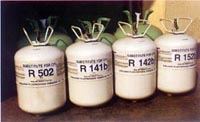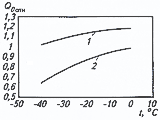

| NEWS | |||||||
| ABOUT | |||||||
| PRODUCTS AND SERVICES | |||||||
|
| |||||||
| PLACE AN ORDER | |||||||
| DOWNLOAD | |||||||
| HELPFUL HINTS | |||||||
| FAQ | |||||||
| LINKS | |||||||
| SEARCH | |||||||
| SITE MAP | |||||||
| CONTACT | |||||||
| русский |
Alternative refrigerants for refrigerating transport
Cargo vessels with the refrigerating holds constitute a considerable part of the refrigerating fleet designed to transport cargoes to long distances. Ammonia was the first refrigerant used with this purpose. However, by 80-ties it has become to a great extent substituted by R22 mainly because the work with ammonia increases the risk of emergency conditions. In seventies all the large-capacity refrigerating vessels were equipped with the refrigeration systems using R22 as a refrigerant. By that time in the refrigeration containers there was already widely used R12. Later in the systems of ground trailer transportations there was also widely spread R502. Step-by-step reduction of HFC production in accordance with the Montreal Protocol seriously effected industry producing refrigeration containers, trailer autorefrigerators and refrigeration vessels. At present there is widely used R134a as a refrigerant in the refrigeration containers. Recently there has appeared information about creation of two new refrigerants (R413A and R407D), based on HFC, which does not have the drawbacks peculiar for R134a compared to R12. New refrigerant R407D is compatible with polyester refrigeration oils and has much higher condensation pressure than R12 or R401B. Refrigerants alternative to R502 and R22. When prohibition of HFC has officially come into force, development of substances alternative to R502 has followed two directions:
Development of R404A refrigerant which is the blend f several HFC, whose operation performance is close to that of R502 (see the table) gave the possibility to substitute both R22 and R502 in the low-temperature refrigeration equipment.
* In the cycle with boiling point t0 = -40 oС and condensation point tK = 50 oС. Some producers of refrigeration containers have succeeded by now in adapting of R404A as the standard refrigerant for operation in the low temperatures. One more refrigerant R507, close to R404A as to its performance, can be used in these cases. However, R507 has higher pressure which is a bit higher than the standard (2,5 МPа at temperature 55 oС). Triple blends based on R32 and constituting the series of R407 refrigerants, have not been yet accepted by the leading producers of transport refrigeration equipment as refrigerants for standard charging. A new refrigerant on the base of HFC (R410A) has been first developed to substitute R22 in the air-conditioning facilities and has been introduced as a refrigerant for trailer autorefrigerators. Since R410A is a high-pressure refrigerant, components of the refrigeration systems have to be specially designed for operation in such conditions. Refrigerants alternative to R12. The majority of different kinds of the refrigeration transport operates on CFH. Those of them using R12 to keep low temperatures face with a particularly serious problem because R134a refrigerant substituting R12 has considerably lower operation performance at lower boiling points. In practice some specialists take a compromise decision: they substitute R12 for R134a in the refrigeration facility first mounted in a large-capacity container, and then the same refrigeration facility is placed into a small-capacity container. But substitution of R502 for R404A is not connected with the necessity to carry out such measures. In both cases in order to change the refrigeration facility from the refrigerant related to CFC group to the refrigerant on the base of HFC, substitution of the mineral oil for the synthetic oil is required. Before substitution they thoroughly wash the system to eliminate the oil residue, because if it constitutes more than 5 %, there can occur serious mechanic damage of the refrigeration equipment.
At present for substitution of R12 in the refrigeration systems of containers they use R401B, which is especially interesting because its cold-productivity at low temperatures corresponds to the cold-productivity of R12 (see the figure). For retrofit of the refrigeration systems of autorefrigerators operating on R12, they use R401C, and R402A and R403B are used, first of all, to substitute R502. Using of such service blends is economically effective in refrigeration containers, as well in autorefrigerators of the old type before termination of their operation service life. R413A, offered on the market as a service refrigerant compatible with the mineral oil and intended to substitute R12, consists basically of R134a and in the area of low temperatures it has operation characteristics peculiar to this refrigerant. In case of forced delivery of the refrigerant into the evaporator (evaporator of flooded type), R404A is considered to be a perspective refrigerant for operation in the area of low temperatures. It is expected that this refrigerant will play the leading part in cooling of cargoes on vessels. Specific requirements made toward the refrigeration transport include not only technical aspects of operation indicators but also not less important considerations of organization of material and technical provision. It allows to assume that in the near future R134a, R404A and R407C, complying with strict ecological and technical requirements and available all around the world, will take the firm stand among refrigerants for vessels-refrigerators, containers- refrigerators and transport means with cargo cooling. Step-by-step cessation of HCFC production hastened development of vessel refrigeration facilities of the new type. If for cargo cooling average or high temperatures are required, refrigerating facilities with big charging capacity used at present are substituted with compact chilling facility. In such facilities there is observed return to using of ammonia. Ammonia refrigerating facility can be located in the isolated place equipped with the scrubber system for absorbing of possible ammonia leakage. | |||||||||||||||||||||||||||
 General. Refrigerating transport ensures transportation of cargoes from places of their production to the places of retail. Development of safe types of the refrigerating transport resulted in expansion of the sphere of its use. At present there is realized transportation of a wide range of food and non-food products in the world. Thus, according to specialists estimations, only container refrigerators being operated are about 400 thousand in number. With the advent of specialized vehicles-refrigerators, both intercontinental and international transportation of cargoes has been considerably facilitated.
General. Refrigerating transport ensures transportation of cargoes from places of their production to the places of retail. Development of safe types of the refrigerating transport resulted in expansion of the sphere of its use. At present there is realized transportation of a wide range of food and non-food products in the world. Thus, according to specialists estimations, only container refrigerators being operated are about 400 thousand in number. With the advent of specialized vehicles-refrigerators, both intercontinental and international transportation of cargoes has been considerably facilitated.